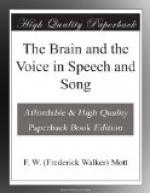temperament, so modulate his voice as to convey to
his audience the passions and emotions while feeling
none of them himself; so many great singers who are
possessed of a good musical ear, a good memory, and
natural intelligence, although lacking in supreme
artistic temperament and conspicuous musical ability,
are nevertheless able to interpret by intonation and
articulation the passions and emotions which the composer
has expressed in his music and the poet or dramatist
in his words. The intelligent artist possessed
of the musical ear, the sense of rhythm, and a well-formed
vocal organ accomplishes this by the conscious control
and management of his breathing muscles and the muscles
of articulation, which by education and imitation he
has brought under complete control of the will.
With him visual symbols of musical notes are associated
with the visual symbols of words in the mind, and the
visual symbols whether of the words or of the musical
notes will serve to revive in memory the sound of
the one or the other, or of both. But he produces
that sound by alteration of tension in co-ordinated
groups of muscles necessary for vocalisation,
viz.
the muscles of phonation in the larynx, the muscles
of articulation in the tongue, lips, jaw, and palate,
and the muscles of costal respiration.
The mind
of the orator, actor, and dramatic singer exercises
a profound influence upon the respiratory system of
nerves, and thereby produces the necessary variations
in the force, continuance, and volume of air required
for vocal expression.
Sir Charles Bell, who discovered the respiratory system
of nerves, pointed out how the lungs, from being in
the lower animals merely the means of oxygenating
the blood, become utilised in the act of expelling
air from the body for the production of audible sounds—the
elements of human voice and speech. Likewise
he drew attention to the influence which powerful emotions
exercise upon the organ of respiration, including the
countenance, e.g. the dilated nostrils in anger.
Again, “when the voice suffers interruption and
falters, and the face, neck, and chest are animated
by strong passion working from within the breast,
language exerts its most commanding influence.”
In hemiplegia or paralysis of one half of the body,
there is a difference between the two sides for ordinary
automatic unconscious diaphragmatic breathing and
voluntary or costal breathing. Thus in ordinary
breathing the movements are increased on the paralysed
side, especially in the upper part of the chest, while
in voluntary breathing they are increased on the sound
side. Hughlings Jackson suggested the following
theory to explain these facts: “Ordinary
breathing is an automatic act governed by the
respiratory centre in the medulla. The respiratory
centre is double, each side being controlled or inhibited
by higher centres on the opposite side of the brain.
Voluntary costal breathing, such as is employed in




